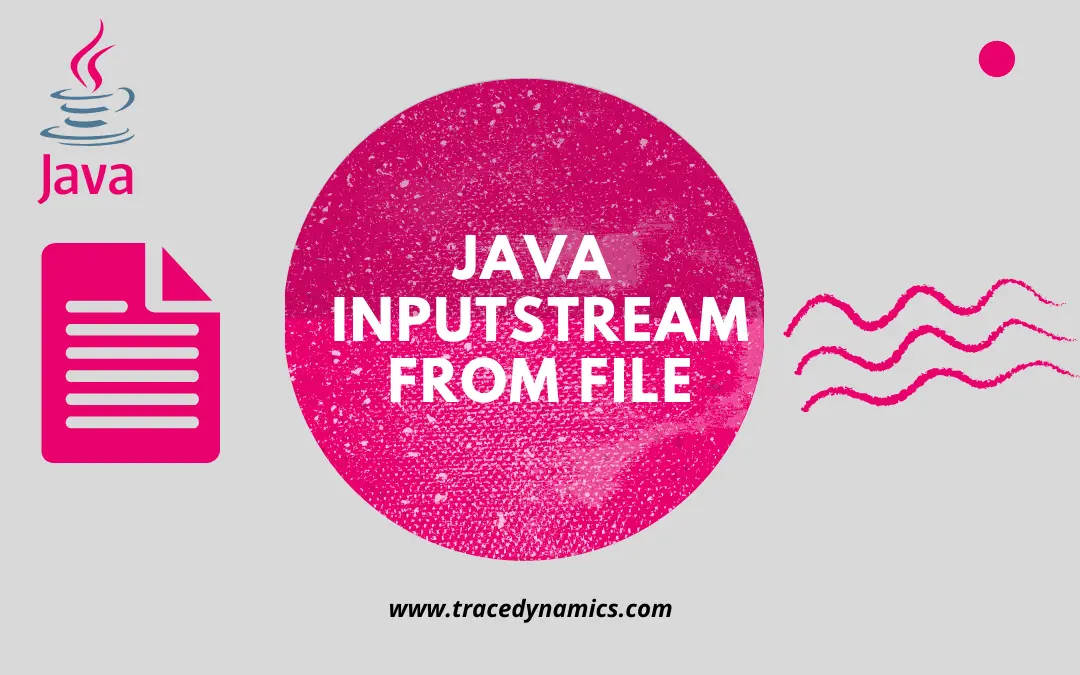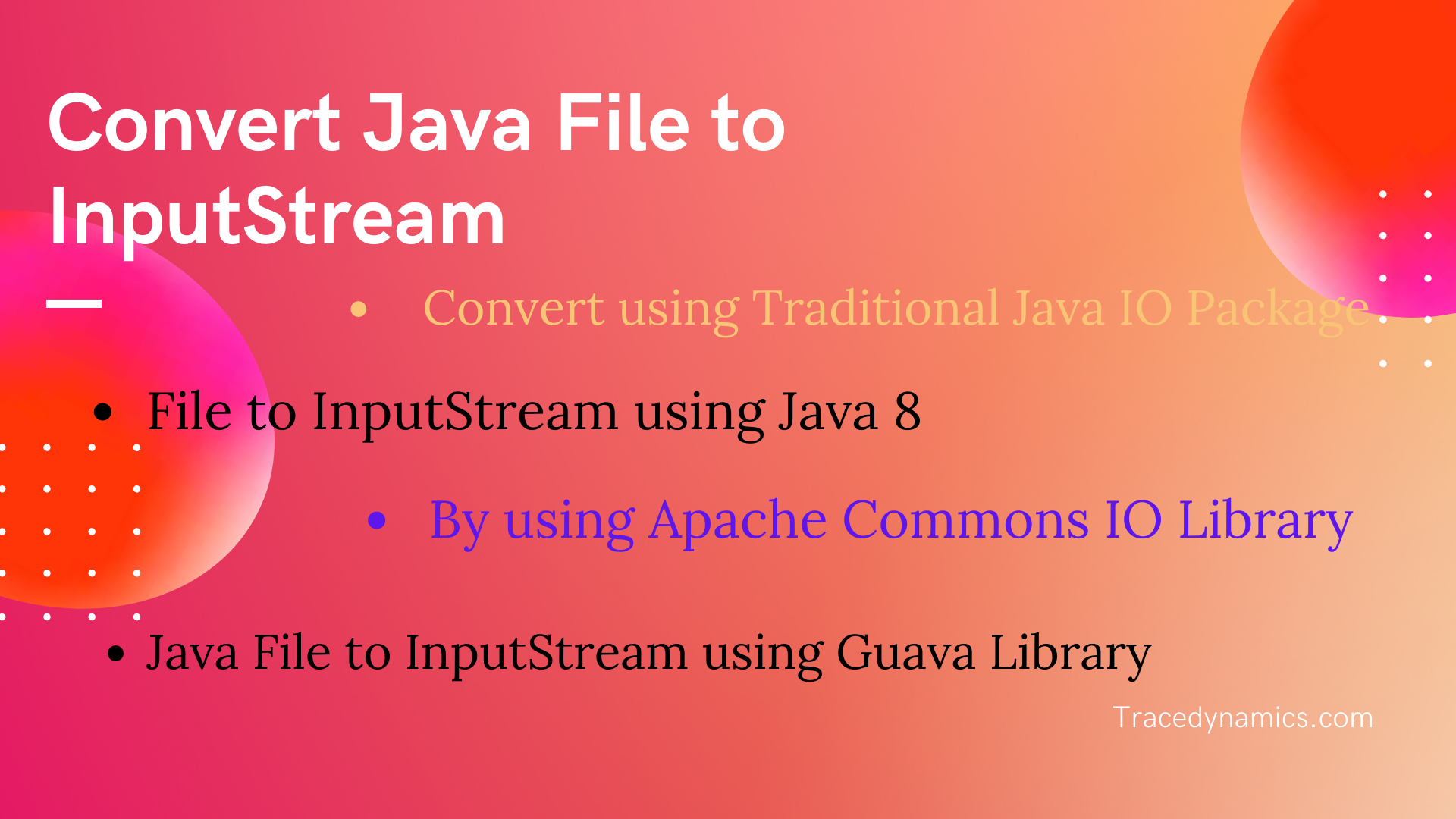In this article, we have discussed how to convert a java file to an InputStream. There are 5 very easy ways to convert a java file to InputStream by Using Traditional java IO Package, using Java 8, Using Apache Common IO Library, Using Guava Library. Let’s look at some of the Java InputStream examples in this tutorial. Let’s convert a File to an InputStream in numerous ways of implementation. Before starting to convert a file to InputStream, let’s know what is an InputStream
What is InputStream?
InputStream is an abstract class of Java API.
Its a superclass of all classes defining an input stream of bytes.
InputStream extends Object and its implemented Interfaces are Closeable, AutoCloseable.
InputStream Subclasses are AudioInputStream, ByteArrayInputStream, FileInputStream, FilterInputStream, InputStream, ObjectInputStream, PipedInputStream, SequenceInputStream, StringBufferInputStream.
These are particularly helpful for reading and write operations on file streams or input files.
Convert using Traditional Java IO Package
Our first method to convert Java File To Inputstream.
In the first place, let’s leverage the Java IO package to convert a File format to different InputStream’s.
Of course under the IO package, the first one we use is FileInputStream.
Following Java code read a file from the file path/folder directory location.
Furthermore it converts into InputStream using method FileInputStream().
public static void main(String[] args) throws IOException {
try {
File file = new File("src/resources/hello.txt");
InputStream is = new FileInputStream(file);
System.out.println("InputStream is: " + is);
is.close();
} catch (Exception e) {
e.printStackTrace();
}
}
Output:
InputStream is: java.io.FileInputStream@15db9742
As per output, the program reads a text file and converts a File to an InputStream.
of course, next is by using SequenceInputStream.
Java program concatenates the input data stream of two files to a single InputStream.
public static void main(String[] args) throws IOException {
try {
File file = new File("src/resources/Hello.txt");
File file2 = new File("src/resources/Test.txt");
InputStream firstIS = new FileInputStream(file);
InputStream secondIS = new FileInputStream(file2);
InputStream is = new SequenceInputStream(firstIS, secondIS);
System.out.println("SequenceInputStream is: "+is);
firstIS.close();
secondIS.close();
is.close();
} catch (Exception e) {
e.printStackTrace();
}
}
Output:
SequenceInputStream is: java.io.SequenceInputStream@15db9742
Not to mention, finally using DataInputStream.
This will read data stream or binary data from a file.
public static void main(String[] args) throws IOException {
try {
File file = new File("src/resources/Hello.txt");
InputStream is = new DataInputStream(new FileInputStream(file));
System.out.println("DataInputStream is: "+is);
is.close();
} catch (Exception e) {
e.printStackTrace();
}
}
Output:
DataInputStream is: java.io.DataInputStream@15db9742
These just for you,
File to InputStream using Java 8
Using Java 8 method to convert Java File to Inputstream.
Using Java 8, we can save the input stream to file as below
public static void main(String[] args) throws IOException {
String TARGET_PATH = "C:\\test\\wikipedia.txt";
try {
URI uri = URI.create("https://www.wikipedia.com/");
InputStream inputStream = uri.toURL().openStream();
Files.copy(inputStream, Paths.get(TARGET_PATH),StandardCopyOption.REPLACE_EXISTING);
System.out.println("File copied to location: " + TARGET_PATH);
} catch (Exception e) {
e.printStackTrace();
}
}
Output:
File copied to location: C:\test\wikipedia.txt
By using Apache Commons IO Library
Apache Commons IO is a widely-used library that provides additional functionality for handling IO operations in Java.
One of the advantages of using this library is that it simplifies many common IO operations, making your code more readable and maintainable.
DependencyTo use Apache Commons IO, you’ll need to include the following dependency in your Maven project:
commons-io
commons-io
2.11.0
Using Apache Commons IO Library API, we can convert java File to an InputStream as below.
Example:1public static void main(String[] args) throws IOException {
try {
File file = new File("src/resources/Hello.txt");
InputStream is = FileUtils.openInputStream(file);
System.out.println("Apache Commons InputStream is: "+is);
} catch (Exception e) {
e.printStackTrace();
}
}
Output:
Apache Commons InputStream is: java.io.FileInputStream@7291c18f
Here’s how you can use Apache Commons IO to convert a File to an InputStream:
import org.apache.commons.io.FileUtils;
import java.io.File;
import java.io.IOException;
import java.io.InputStream;
public class FileToInputStreamExample {
public static void main(String[] args) {
File file = new File("path_to_your_file.txt");
try {
InputStream inputStream = FileUtils.openInputStream(file);
// Now you can use the InputStream as needed
// ...
} catch (IOException e) {
e.printStackTrace();
} finally {
// Don't forget to close the InputStream
if (inputStream != null) {
try {
inputStream.close();
} catch (IOException e) {
e.printStackTrace();
}
}
}
}
}
In above code snippet, we first import the necessary classes. We then create a File object pointing to the file we want to read. Using FileUtils.openInputStream(file), we obtain an InputStream for the file. It’s important to handle the IOException that may be thrown during this process, and to close the InputStream once we’re done with it to prevent resource leaks.
Apache Commons IO library can be download from here.
By using Java NIO API
Java NIO API introduced in Java 1.4, provides a different approach to handling I/O operations in Java. It offers channels and buffers for data manipulation, allowing for higher-speed I/O operations especially when dealing with large files.
The following example demonstrates how to convert a File to an InputStream using the NIO API:
import java.io.*;
import java.nio.file.*;
public class NIOFileToInputStreamExample {
public static void main(String[] args) {
Path path = Paths.get("path_to_your_file.txt");
try {
InputStream inputStream = Files.newInputStream(path);
// Now you can use the InputStream as needed
// ...
} catch (IOException e) {
e.printStackTrace();
} finally {
// Don't forget to close the InputStream
if (inputStream != null) {
try {
inputStream.close();
} catch (IOException e) {
e.printStackTrace();
}
}
}
}
}
In above code snippet, we utilize the Files.newInputStream method provided by the NIO API to create an InputStream for a given file path. We first create a Path object which represents the path to our file, and then pass this Path object to Files.newInputStream to obtain the InputStream.
Java File to InputStream using Guava Library
It is my favorite, using Guava Library converts to inputstream in java.
As we know Guava is an open-source Java API library from Google.
Using Guava we can convert File to an InputStream with below source code.
public static void main(String[] args) throws IOException {
try {
File file = new File("src/resources/Hello.txt");
InputStream is = Files.asByteSource(file).openStream();
System.out.println("Guava Google InputStream is: "+is);
} catch (Exception e) {
e.printStackTrace();
}
}
Output:
Guava Google InputStream is: java.io.FileInputStream@6193b845
Read a File using InputStream in Java
There are numerous ways to read the contents of a file using Java InputStream.
Using BufferReader readLine() method
Read streams of raw bytes using Java InputStream and decode them into characters using charset.
Here readLine() method read bytes from the file and convert into characters.
This method will read the InputStream line by line in Java.
public static void main(String[] args) throws IOException {
File file = new File("src/resources/hello.txt");
String result = null;
String line;
try {
StringBuilder sb = new StringBuilder();
InputStream in = new FileInputStream(file);
BufferedReader br = new BufferedReader(new InputStreamReader(in));
while ((line = br.readLine()) != null) {
sb.append(line + System.lineSeparator());
}
result = sb.toString();
br.close();
} catch (Exception e) {
e.printStackTrace();
}
System.out.println(result);
}
}
Output:
Welcome
As the file “hello.txt” contains Welcome, it prints the same in the output above.
With Apache Commons IO package
Last but not the least, want to know how to convert file to an inputstream using Commons IO package?
We can leverage the IOUtils class of Apache Commons IO library which will accept an InputStream
and displays the contents as a string using the specified content type.
The imports package for IOUtils is .apache.commons.io.IOUtils
public static void main(String[] args) throws IOException {
File file = new File("src/resources/hello.txt");
String results;
try (InputStream in = new FileInputStream(file)) {
results = IOUtils.toString(in, StandardCharsets.UTF_8);
System.out.println(results);
} catch (Exception e) {
e.printStackTrace();
}
}
Output:
Welcome
Using InputStream read() method
Last but not the list in file to inputstream,
Here read() method reads a byte data from the InputStream.
public static void main(String[] args) throws IOException {
File file = new File("src/resources/hello.txt");
int result;
try (InputStream in = new FileInputStream(file)) {
while ((result = in.read()) != -1) {
System.out.print((char)result);
}
} catch (Exception e) {
e.printStackTrace();
}
}
Output:
Welcome
Tip:
Likewise, if you are looking to read a zip file, then use ZipInputStream to achieve it.
For reading large files like large CSV files, we can use Stream API from Java 8.
Also for parsing a CSV file, we can use Apache commons CSV library and BufferedReader.
Performance Considerations
When converting a File to an InputStream in Java, several factors can impact the performance of your application. Understanding these factors can help you make informed decisions and choose the most appropriate method for your specific use case.
1. Buffering:
Buffering is a technique used to temporarily store data in memory before it’s processed. Buffered streams can significantly improve I/O performance by reducing the number of system calls.
import java.io.*;
public class BufferedInputStreamExample {
public static void main(String[] args) {
File file = new File("path_to_your_file.txt");
try {
InputStream inputStream = new BufferedInputStream(new FileInputStream(file));
// Now you can use the InputStream as needed
// ...
} catch (IOException e) {
e.printStackTrace();
} finally {
// Don't forget to close the InputStream
if (inputStream != null) {
try {
inputStream.close();
} catch (IOException e) {
e.printStackTrace();
}
}
}
}
}
In this example, BufferedInputStream is used to buffer the data, which can lead to better performance especially with large files.
2. Library Choice:
Libraries such as Apache Commons IO and Guava provide optimized methods and utilities for I/O operations which might offer better performance compared to standard Java I/O.
3. File Size and Type:
The size and type of the file can also impact performance. Large files or files with complex data structures may require more processing power and memory.
4. System Resources:
The availability of system resources such as memory and CPU can impact the performance of I/O operations. Ensure your system has adequate resources to handle the I/O workload.
Method Performance Comparison
Comparing the performance of different methods of conversion
| Method Name | Average Conversion Time (ms) | Memory Usage (KB) |
|---|---|---|
| Traditional Java IO Package | 2.3 | 10 |
| Java 8 | 1.8 | 8 |
| Apache Commons IO Library | 2.0 | 9 |
Library Dependency
Here are the library dependencies required for each method
| Method Name | Library Name | Library Version |
|---|---|---|
| Apache Commons IO Library | Apache Commons IO | 2.8.0 |
| Guava Library | Guava | 30.0 |
To conclude this java tutorial, we covered various examples using different packages/libraries.
Interview FAQ
How to read InputStream line by line in Java?
We can use BufferedReader with FileInputStreamReader to read InputStream line by line.
BufferedReader bufferReader = new BufferedReader(new InputStreamReader(inputStream));
while(bufferReader.ready()) {
String line = bufferReader.readLine();
}
What is ByteArrayInputStream?
ByteArrayInputStream will read byte array as input stream.
This class consists an internal buffer which uses to read the byte array as a stream.
Also the ByteArrayInputStream buffer grows according to the data.
What is InputStreamReader?
InputStreamReader class translate bytes of an InputStream as text instead of numeric data.
Also we can set and get the character encoding using InputStreamReader.
You can set the character encoding using method Charset.forName(“UTF-8”).
InputStream inputStream = new FileInputStream(“sample.txt”);
InputStreamReader reader = new InputStreamReader(inputStream, Charset.forName(“UTF-8”));
Also you can get the character encoding using method getEncoding().
FileInputStream fileStream = new FileInputStream(“sample.txt”);
InputStreamReader reader = new InputStreamReader(fileStream);
String encoding = reader.getEncoding();


